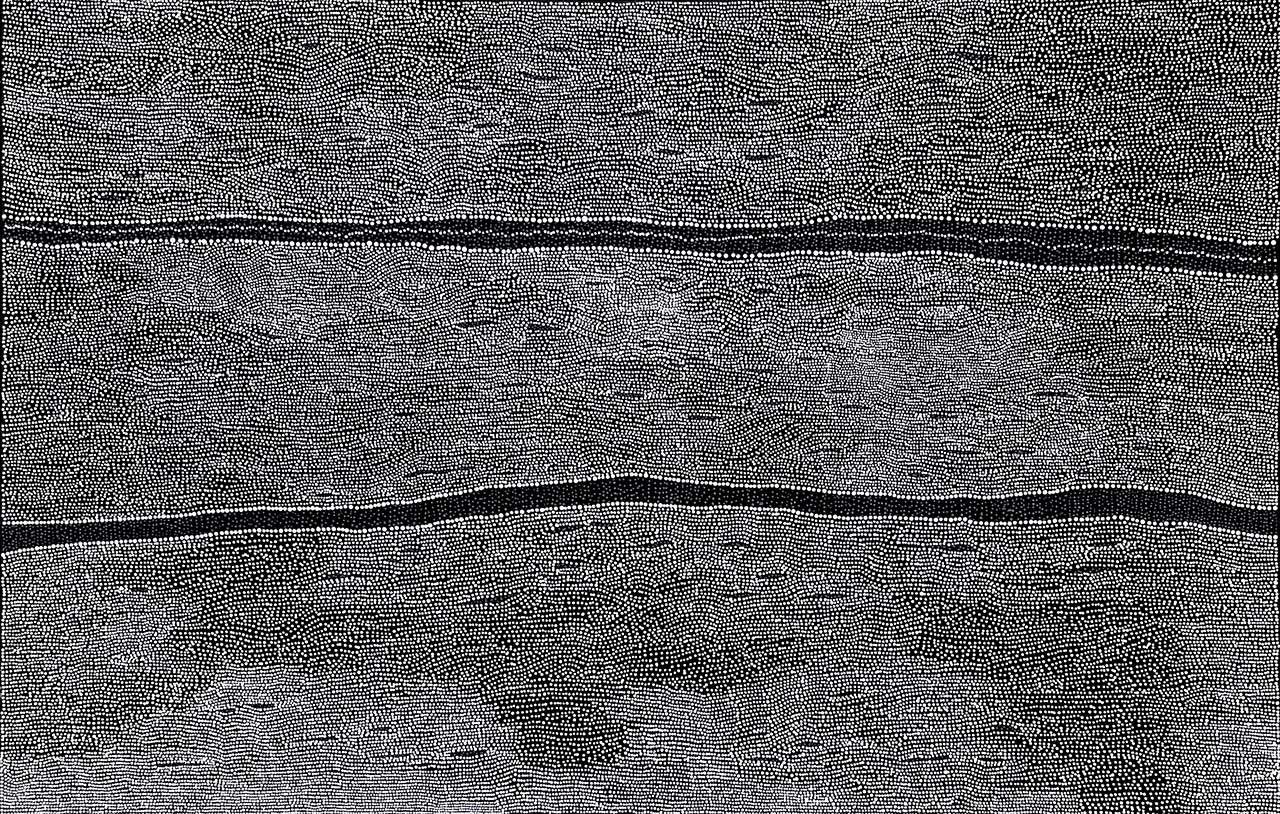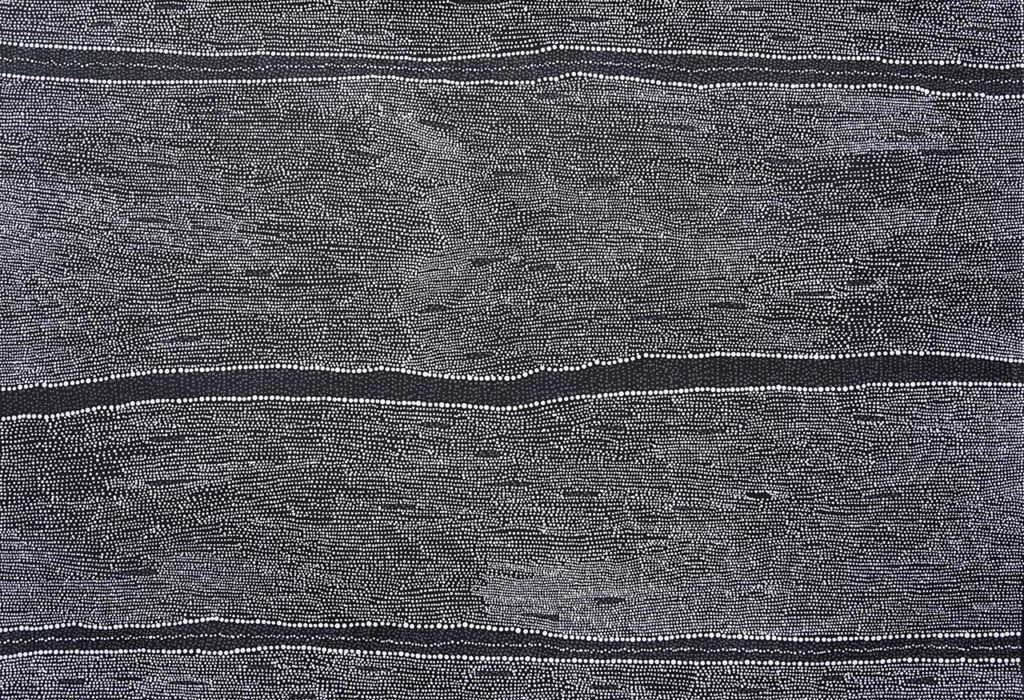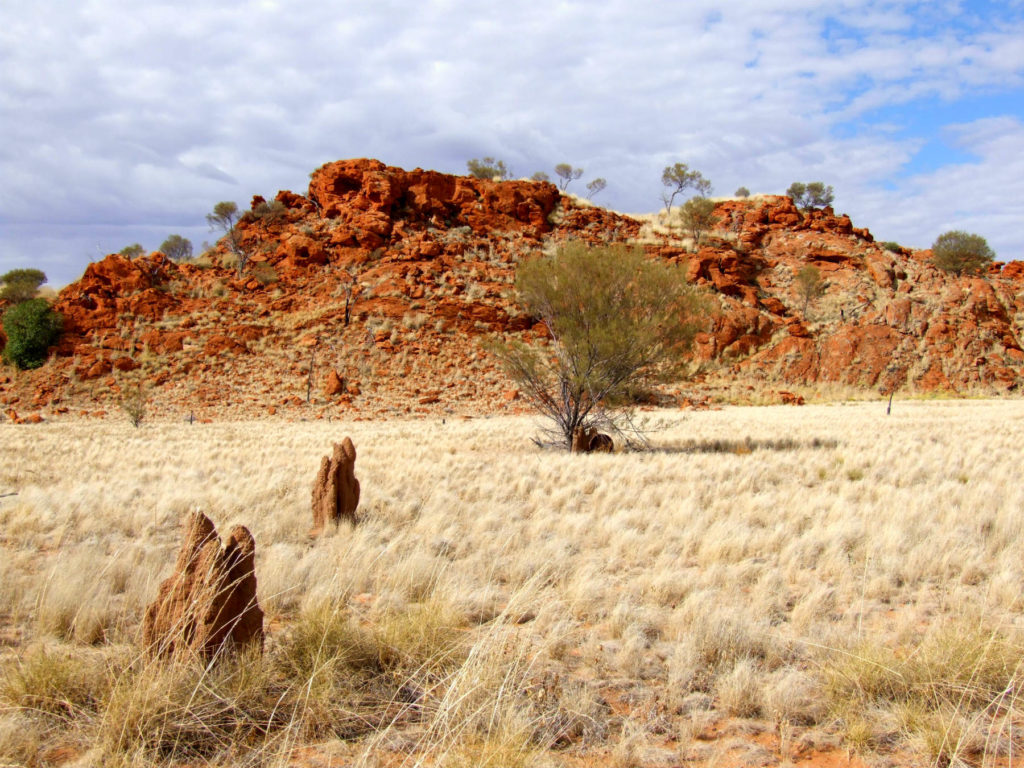Pirlinyanu by Julie Nangala Robinson

Our last exhibition by Julie Nangala Robinson was an unqualified success. We've never had so many inquiries about an exhibition, and it virtually sold out within a few days. We were swamped with email inquiries as soon as the invitations went out and sales over the phone and by people rushing into the gallery. So much so that by the opening night virtually all the paintings were gone. We contacted Julie's agent and said, "Is it possible to get some more because there's strong pent up demand for this artist." And we were very fortunate, she had this major work, around three metres wide, an aerial view of her country, but it has the same ethereal feeling as her mother's paintings, Dorothy Napangardi, who's widely recognised as one of the greats. It is in black and white, but it's got that sense of calmness about it. It is a powerful painting, yet calming and relaxing when you look at it. And it's not static, it's got beautiful subtleties through it and movement. This is a major painting by a really exciting up and coming artist.
The central story of all of Julie's paintings has been Pirlinyanu, which is her dreaming site on her father's side. And this is a site that exists on the Ngapa Jukurrpa or water dreaming song line. The painting suggests the open country of the Tanami Desert, where Pirlinyanu is. It also suggests the song line travelling across vast distances and always the sense of rain. There is also a sense of there being a water barrier almost, as though there's cloud or something that's bringing the rain into the picture, into the song that is underlying the story. This very large three metre painting is the quintessential story of rain dreaming coming from Julie's heritage.

Dorothy Napangardi's Manager and long time friend, Roslyn Premont discusses a Pirlinyanu by Julie Nangala Robinson who is one of Dorothy’ Napangardi'ss talented daughters.
This work is at once an aerial perspective of Julie Nangala Robinson's country but it is also looking across at her country in a more lateral view.
Pirlinyanu is a rocky outcrop with many natural occurring wells. The water is running down into the wells which is symbolised by the rhythm of the dots. The white and the grey, is imagining that the clouds are coming and that it is the hope of rain. It's almost like singing up rain in the colours of that kind of blue-grey colour that's been used. The colours suggest that the clouds are getting darker. There's the feeling of the rain draining down and the rock holes filling with that rain.
At times of intense rain, you also have rivers that form. It could be that the water is swelling and the rivers are coming down or the waters going into the wells. The movement of the dots is the falling rain, it's all in the way that the rain is rolling down onto the rocky outcrop.
This work does remind me of Dorothy's work. Not that I think that she was trying to copy Dorothy but her mother’s influence is there. It certainly is an exquisite piece and it has the qualities of a painting that would very neatly fit into a collection. I think an important work from Julie.
It's got her individual hand to it - it's not a copy of Dorothy's work. Some family members and others have been so inspired that they almost looked too close to Dorothy, and Dorothy didn't like that. She was quite happy for people to find their own voice. The Dreaming isn't the same anyway, as I mentioned, because it's not their country.
When I look at this work I think, "Wow!" This work could easily be the work of a very important artist instead of an emerging artist. There is something caught, there is an energy that feels close to the power I feel when I look at Dorothy's work.
It's an exquisite example of a major work from Julie. Not many major works have been done by her.
Just looking at it I feel proud. I am truly inspired by the beauty of it and I would always want to live with it. I wish I had a wall big enough so that I could live with it. I just love it. I feel like I want to own it. I feel, wow, that's something I would love to live with. I recommend that if someone has the wall space for that right now, I would recommend that this is a work of great significance.
I think it's a good time to buy Julie's work, because I'm sure she will just get stronger and increasingly appreciated and this is the prime, an excellent example of her work.
I sent this through to Japingka thinking about collectors who'd fallen in love with Dorothy's work and couldn't quite afford it. It occured to me how much they would love to see this and I hoped they would get to see it.

